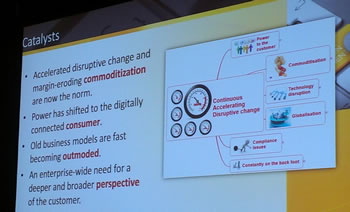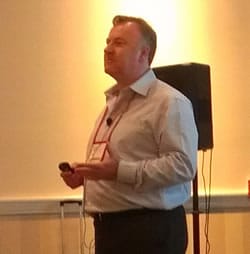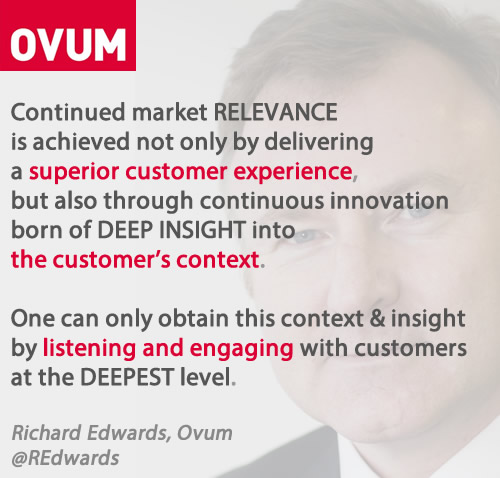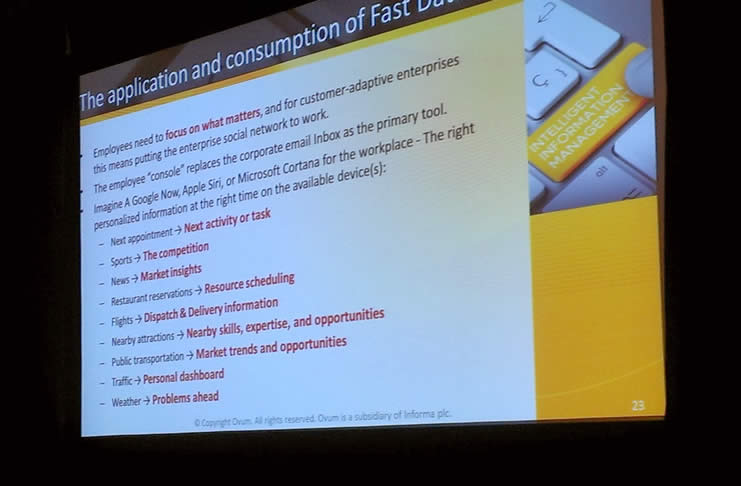Organizations realize that the real-time economy and empowered customer are among many other reasons why the connected customer experience and the customer in the broadest sense (including his life cycle) are at the center of business success.
Business agility and speed have become an essential element in digital transformation and being more customer-centric. And big data analytics has become key to achieve it.

Forrester urges businesses to be “customer-obsessed”. Others use comparable terms to push the 360° customer-centric must. The time for such messages is there, even if we’ve been shouting it for ages. It seems organization are finally ready (and have no choice than) to listen to these messages.
Fast data – the V of big data for the age of the customer
We had the opportunity to meet Richard Edwards (Ovum, now Omdia, part of Informa Tech) at Global Directions, an event organized by Alaris, where Richard talked about being ‘customer-adaptive’, a stage – or state – most organizations have certainly not reached yet.
Richard especially tackled the velocity component of Big Data – Fast Data – that has a lot to do with the ability to be customer-adaptive in times where the speed of business is changing fast. An interview about a customer-oriented topic where technology/IT and business connect in digital transformation.
Getting a handle on Big Data and Fast Data can help organizations sense change within their markets and customer bases, and then do something about it (Richard Edwards)
If you haven’t heard about Fast Data yet, Tony Baer wrote an article back in 2012, emphasizing that “Fast Data encompasses high-performance, low-latency complex event processing (CEP) applications, where data streams are processed in memory to detect otherwise indecipherably sophisticated patterns.” Unfortunately the article isn’t online anymore but let’s keep it simple: Fast Data is really closely related with the real-time dimension of business and the need for speed and velocity in a big data environment.
Customer and market relevance: context is king

Your colleague Tony Baer wrote about the new urgency for organizations to gain a complete picture of their environment, rapidly, as a result of the explosion of data. He said Fast Data goes mainstream and explained it very well. While there’s a technology side to it, you look at the business benefits as well. Can you share some thoughts on the link between Big Data, Fast Data and business outcomes?
Richard Edwards: Today’s fast-moving business environments presents major opportunities for enterprises that have the vision to raise their sights and their games to become “customer-adaptive”.
The customer-adaptive enterprise is driven by a desire and strategic intent to create and deliver value and be persistently relevant to its customers.
Continued market relevance is achieved not only by delivering a superior customer experience, but also through continuous innovation born of deep insight into the customer’s context. One can only obtain this context and insight by listening and engaging with customers at the deepest level. It is impossible in many markets to listen and engage with every customer 24 x 7, so organizations need to augment their customer sales/service teams with technology solutions that exploit rich data sources.
Why getting a handle on big data and fast data matters
A customer-adaptive enterprise will obtain this context and insight through the inclusion and analysis of adjacent data sources relevant to their market and customer base – this is where “Big Data” comes in. Increasingly, this contextual “environmental” data is transient or none persistent – this is where the term “Fast Data” comes in.
Getting a handle on Big Data and Fast Data can help organizations sense change within their markets and customer bases, and then do something about it.
Jack Welch, former CEO of General Electric once said: “If change is happening faster on the outside than on the inside then the end is in sight.”
Superior customer experiences and a loop of insights through actionable data and delivering value. Can you give some examples of how Fast Data can improve customer experiences, service and satisfaction?
Richard Edwards: 52% of consumers now use three or four channels to interact with an organization. These might be via telephone, via letter, via email, in person, or via Facebook (note: unstructured communication channels and unstructured data sources such as social, email and text files are the fastest growing type of data). Understanding the customer’s interactions with the organization requires a high degree of cross-channel connectivity and intelligence.
Cross-referencing the context and purpose of these interactions with other customer interactions can provide the organization with powerful insights. These insights could be an early warning of trouble ahead or they may serve to highlight a new business opportunity.
Knowledge management, customer service and getting the right answer – fast
The contact center is one of the entry points of big data analytics into the enterprise and it’s increasingly about a unified approach revolving around an omni-channel customer. Voice of Customer Analytics become more important and the mantra “be where your customers are” is often heard. Yet, at the same time customers often still use traditional channels to seek service or interact. What’s your take on this? Should an organization be and listen where its customers are? How do you prioritize? How do you set up the internal processes of listening and responding? How do you connect it all in a unified context?
(Note: although it’s a big topic and Ovum has contact center experts, Richard was kind enough to offer his viewpoint).

Richard Edwards: Knowledge workers are engulfed in an avalanche of data. Indeed, some are almost becoming ‘digitally snow blind’ as they stare at endless screens of information, trying to decide which response, link or search result will provide them with the information they need to respond to the customer enquiry or deal with the business issue.
Traditional information and knowledge management solutions provide users with a place to look for answers, but alas they provide very little guidance on whom to ask. Knowing whom to ask in a small team, large department, organization or business network can often be of critical importance in terms of getting the right answer, so social search and analytics is, in my opinion, of great importance to all businesses and institutions.
Unified communication and collaboration solutions have been one area of exploration for the contact center, but I think the next iteration of developments in the enterprise social networking market will provide employees with a useful and purposeful console for their daily activities.
If the rate of change is too great, organizations can’t follow the path
In an interview about Ovum’s Enterprise 2020 report, you say, I quote “The way in which we work will change dramatically over the next seven years, more than in the previous 30, meaning the enterprise will need to be more agile and more responsive than it is today”. Do you think it will take that long or are things changing faster since than expected? What should business do now to be ready?
Richard Edwards: The rate of change of pretty much everything in modern day life seems to be increasing. However, we, the human beings in this equation, are the governing factor.
If the rate of change is too great, then the “slope” it creates becomes too steep and we can’t follow the path. Organizations must therefore pay more consideration to the human factors associated with technological change.
I often ask the question: When was the last time your employer provided you with any formal IT or systems training ? Most people can’t remember when! Relative to the technology around us, IT literacy is falling, and therefore organizations are not fully exploiting, or capitalizing upon, their IT investments. So, organizations should better educate and develop the workforce and retool them so they are ready for the new world of work (which is already here in many cases!).
Big Data/Fast Data to maintain relevance to the organization
There’s a strong link between UC&C, Enterprise 2.0, (intelligent) information management and new ways of working whereby fast access to information, content and data is essential. Today’s knowledge worker increasingly uses mobile devices to access information, collaborate, etc. However, often there is no clear BYOD policy and workers do store and access data in personal content silos. How can organizations strike that balance between security/management and empowering a new breed of workers? Does Fast Data play a role here too?
If the rate of change is too great, then the “slope” it creates becomes too steep and we can’t follow the path.
Richard Edwards: For the masses, BYOD is about getting email on their smartphone. However, for a minority of “power users” it’s about using their own equipment to be more effective in a given situation. It’s all about having the right device, with the right application/information, at the right time.
Often times, employees using mobile devices are in customer-facing roles, so providing useful and purposeful information to these employees via their devices is important when it comes to customer service/support. Google Now is an example of Fast Data at work in the consumer space, so imagine a Google Now for Business and one gets the idea of what this particular data analysis approach might be able to offer.
Finally, can you give us an idea of how you see the evolutions regarding the collaboration between technology and business in the organization with a de facto, be it somewhat exaggerated, disconnect between IT and other departments?
Richard Edwards: I would argue that it’s too much of a generalization to say that there’s a disconnect between IT and other departments such as marketing. However, IT managers can of course help their “customers” within the business, by engaging early and continuously through social tools and utilizing Big Data/Fast Data to maintain their own relevance to the organization.
Indeed, the disconnect is certainly not present in all organizations. Customer-adaptive, it goes beyond customer-centric. And the importance of the human factor, relevance and purpose is clear in Richard’s views on digital transformation and customer-adaptiveness and Fast Data. Thanks to Richard for sharing them. So, are you ready to be customer-adaptive?


